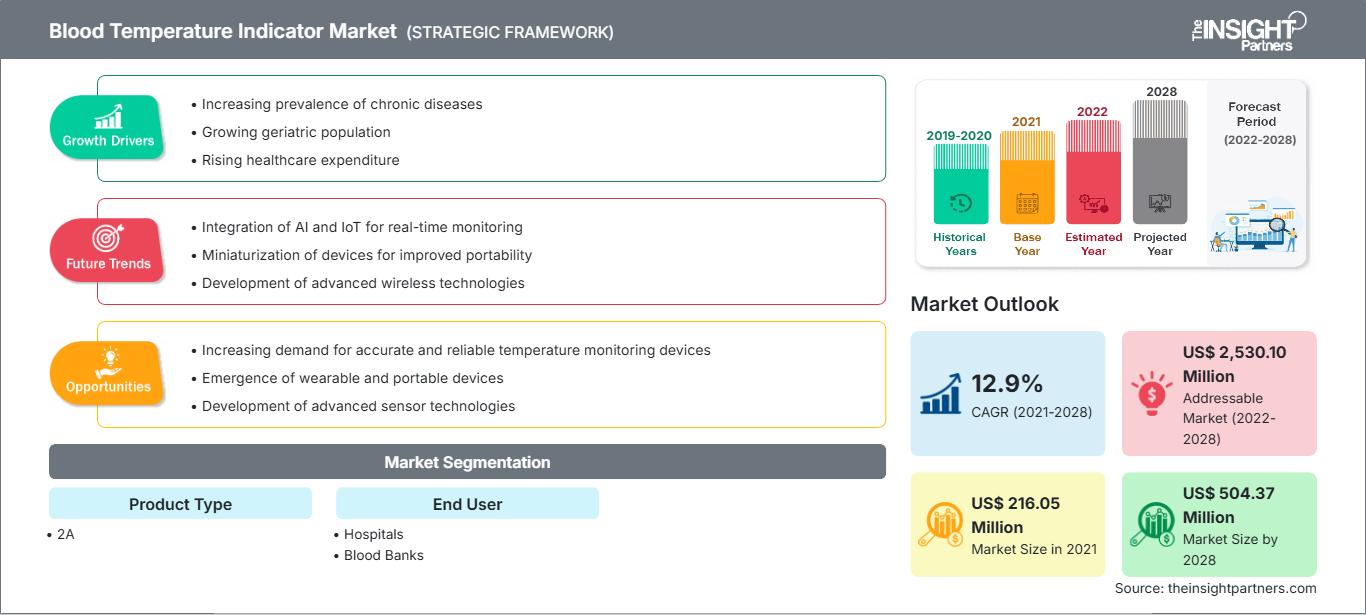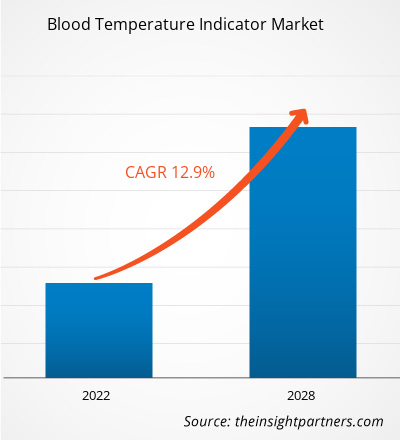Le marché des indicateurs de température sanguine devrait passer de 216,05 millions de dollars américains en 2021 à 504,37 millions de dollars américains en 2028 ; il devrait enregistrer un TCAC de 12,9 % entre 2021 et 2028.
Les indicateurs de température sanguine sont de petits dispositifs ou solutions médicaux qui contribuent à accroître la sécurité sanguine en transportant efficacement le sang et ses composants. Ces indicateurs fournissent une preuve vérifiable que le sang est stocké et transporté conformément aux normes réglementaires, ce qui réduit encore le gaspillage sanguin.
Le rapport fournit des informations et une analyse approfondie du marché des indicateurs de température sanguine, en mettant l'accent sur divers paramètres tels que les tendances du marché, les avancées technologiques et la dynamique du marché. Il fournit également une analyse du paysage concurrentiel des principaux acteurs du marché et l'impact de la pandémie de COVID-19 sur le marché des indicateurs de température sanguine dans toutes les grandes régions. La pandémie de COVID-19 a perturbé les conditions socio-économiques de divers pays à travers le monde. Selon les statistiques de l'OMS de 2021, les États-Unis sont le pays le plus touché au monde par la pandémie de COVID-19, avec le plus grand nombre de cas. Ce nombre élevé a freiné l'économie nord-américaine, en particulier celle des États-Unis. La pandémie de COVID-19 a entraîné des changements technologiques cruciaux pour améliorer les soins médicaux. En raison de la propagation du SRAS-CoV-2, de nombreuses villes sont fermées, ce qui entraîne des annulations de traitements par les médecins et les chirurgiens. La pandémie de COVID-19 a affecté la fabrication et l'approvisionnement d'indicateurs de température sanguine en raison de la perturbation de la chaîne d'approvisionnement mondiale. De plus, les professionnels de santé donnent la priorité aux procédures d'urgence et annulent toutes les interventions chirurgicales non urgentes afin de prévenir la propagation du coronavirus. En 2020, la Food and Drug Administration (FDA) a autorisé l'utilisation d'urgence de plasma de convalescents pour le traitement des patients atteints de COVID-19, ce qui a entraîné une augmentation des dons de sang. De plus, la présence d'acteurs majeurs du marché et leurs diverses collaborations stratégiques sur le marché des indicateurs de température sanguine devraient soutenir la croissance du marché. Par exemple, Timestrip, développeur d'indicateurs intelligents, lance une toute nouvelle gamme de deux indicateurs de température électroniques. Ces indicateurs seront essentiels pour surveiller la sécurité du stockage et du transport de divers produits, notamment les produits pharmaceutiques, les vaccins, les soins de santé, les produits alimentaires, les adhésifs et les encres. La pandémie de COVID-19 a donc eu un impact négatif sur le marché des indicateurs de température sanguine.
Le marché des indicateurs de température sanguine est segmenté par région : Amérique du Nord, Europe, Asie-Pacifique, Moyen-Orient et Afrique, et Amérique du Sud et centrale.
Personnalisez ce rapport en fonction de vos besoins
Vous bénéficierez d’une personnalisation sur n’importe quel rapport - gratuitement - y compris des parties de ce rapport, ou une analyse au niveau du pays, un pack de données Excel, ainsi que de profiter d’offres exceptionnelles et de réductions pour les start-ups et les universités
Marché des indicateurs de température sanguine: Perspectives stratégiques

-
Obtenez les principales tendances clés du marché de ce rapport.Cet échantillon GRATUIT comprendra une analyse de données, allant des tendances du marché aux estimations et prévisions.
Aperçu du marché
L'augmentation des transfusions et des dons de sang stimule le marché des indicateurs de température sanguine
La transfusion sanguine est l'une des procédures couramment utilisées dans les soins de santé, qui aide à maintenir le taux sanguin des patients. Diverses maladies chroniques, interventions chirurgicales et traumatismes nécessitent une transfusion sanguine afin que les patients puissent survivre sans effets secondaires dus à de faibles taux sanguins. Des affections médicales, notamment la thalassémie, le cancer du sang, la drépanocytose, l'anémie et les cas chirurgicaux et traumatiques, entraînent une perte de sang et nécessitent une transfusion sanguine. Selon la Croix-Rouge américaine, environ 16 millions de composants sanguins sont transfusés chaque année aux États-Unis. De plus, la drépanocytose touche 90 000 à 100 000 personnes aux États-Unis ; environ 1 000 bébés naissent avec cette maladie chaque année. Ainsi, la prévalence croissante des maladies chroniques a créé une demande de transfusion sanguine, ce qui devrait stimuler la croissance du marché des indicateurs de température sanguine.
Après le prélèvement, le sang doit être conservé et transporté dans des conditions et à des températures spécifiques. Si le sang est conservé et transporté en dehors de la plage de température spécifique pendant une période prolongée, il perd sa capacité à transporter l'oxygène, ce qui peut entraîner de graves problèmes. De plus, il existe un risque de contamination bactérienne grave si le sang est exposé à des températures élevées. Les indicateurs de température sanguine jouent un rôle important dans le maintien des conditions et de la température requises pour un transport sûr et fiable du sang et de ses composants. Ils réduisent les risques de détérioration du sang en surveillant étroitement la température et en assurant la sécurité du sang pendant le transport. Ainsi, l'augmentation des transfusions sanguines, des dons de sang et la demande croissante de transport sûr du sang et de ses composants créent une demande d'indicateurs de température sanguine, ce qui stimule la croissance du marché.
Informations basées sur le type de produit
En fonction du type de produit, le marché des indicateurs de température sanguine est segmenté en 2 °C à 4 °C, 5 °C à 7 °C et plus de 7 °C. En 2021, le segment 2 °C à 4 °C représentait la plus grande part de marché. La position de ce segment sur le marché a augmenté en raison de son utilisation majeure lors du transport du sang sur de longues distances. Par exemple, conformément aux principales directives européennes et américaines, la température des poches de globules rouges doit être comprise entre 1 °C et 6 °C pendant le stockage et entre 1 °C et 10 °C pendant le transport.
Marché des indicateurs de température sanguineLes tendances régionales et les facteurs influençant le marché des indicateurs de température sanguine tout au long de la période de prévision ont été analysés en détail par les analystes de The Insight Partners. Cette section aborde également les segments et la géographie du marché des indicateurs de température sanguine en Amérique du Nord, en Europe, en Asie-Pacifique, au Moyen-Orient et en Afrique, ainsi qu'en Amérique du Sud et en Amérique centrale.Portée du rapport sur le marché des indicateurs de température sanguine| Attribut de rapport | Détails |
|---|---|
| Taille du marché en 2021 | US$ 216.05 Million |
| Taille du marché par 2028 | US$ 504.37 Million |
| TCAC mondial (2021 - 2028) | 12.9% |
| Données historiques | 2019-2020 |
| Période de prévision | 2022-2028 |
| Segments couverts |
By Type de produit
|
| Régions et pays couverts |
Amérique du Nord
|
| Leaders du marché et profils d'entreprises clés |
|
Densité des acteurs du marché des indicateurs de température sanguine : comprendre son impact sur la dynamique des entreprises
Le marché des indicateurs de température sanguine connaît une croissance rapide, portée par une demande croissante des utilisateurs finaux, due à des facteurs tels que l'évolution des préférences des consommateurs, les avancées technologiques et une meilleure connaissance des avantages du produit. Face à cette demande croissante, les entreprises élargissent leur offre, innovent pour répondre aux besoins des consommateurs et capitalisent sur les nouvelles tendances, ce qui alimente la croissance du marché.
- Obtenez le Marché des indicateurs de température sanguine Aperçu des principaux acteurs clés
Informations sur l'utilisateur final
En fonction de l'utilisateur final, le marché des indicateurs de température sanguine est segmenté en hôpitaux, banques de sang et autres. Le segment des hôpitaux a dominé le marché en 2021.
Les acteurs du marché des indicateurs de température sanguine adoptent des stratégies organiques telles que le lancement et l'expansion de produits pour étendre leur présence et leur portefeuille de produits à l'échelle mondiale.
Profils d'entreprise
- Elitech
- Thero Fisher Scientific Inc.
- Sercalia
- Ellab Group
- Zebra Technologies Corporation
- Lisaline Lifesciences Technologies
- Stream Peak International PTE Ltd
- 3M
- DeltaTrak Inc.
- TimeStrip UK Ltd
- Analyse historique (2 ans), année de base, prévision (7 ans) avec TCAC
- Analyse PEST et SWOT
- Taille du marché Valeur / Volume - Mondial, Régional, Pays
- Industrie et paysage concurrentiel
- Ensemble de données Excel
Rapports récents
Rapports connexes
Témoignages
Raison d'acheter
- Prise de décision éclairée
- Compréhension de la dynamique du marché
- Analyse concurrentielle
- Connaissances clients
- Prévisions de marché
- Atténuation des risques
- Planification stratégique
- Justification des investissements
- Identification des marchés émergents
- Amélioration des stratégies marketing
- Amélioration de l'efficacité opérationnelle
- Alignement sur les tendances réglementaires






















 Obtenez un échantillon gratuit pour - Marché des indicateurs de température sanguine
Obtenez un échantillon gratuit pour - Marché des indicateurs de température sanguine